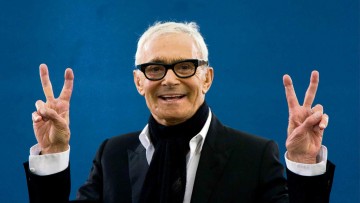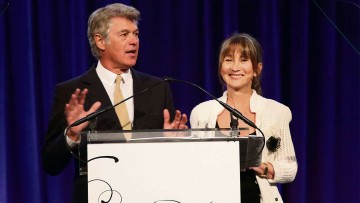Be it New York, London, Milan or Paris, above the whirr of hairdryers backstage at the fashion shows, British voices dominate. It’s the same on shoots for the most influential magazines and super-brands. At the highest creative level, Brits dominate the beauty industry and our hairdressers have never been more in demand.
Stellar stylists, such as Sam McKnight, Eugene Souleimen and Guido, are the taste-makers who decide which hair styles head down catwalks, and influence what everyone the world over wants to look like and subsequently buy.
We know about period hair – other cultures just don’t have the same points of reference
Josh Wood, Yorkshire-born colourist to the fashion elite, salon owner and creator of an eponymous product line that’s flown off shelves in Marks & Spencer, credits British hairdressers’ success to their “exploratory, experimental” attitude.
“Other nationalities are so disciplined it all becomes about the end result. That affects their creativity,” he says, referring to the rich cultural history Brits have to inspire them. “We know about period hair – other cultures just don’t have the same points of reference.”
John Frieda
John Frieda, arguably our most successful hairdressing export when he succeeded in breaking the US market, selling his brand to Kao for a reported $450 million in 2002, says UK hairdressers’ appeal is linked to the seismic effect of the 1960s youth quake. “Fashion reached a new level of respect which influenced the world. It was cool to be a British hairdresser and it still is,” he says.
Vidal Sassoon was the first to monetise his expertise and profile when he launched his hair products in the 70s. Then came John Frieda and Charles Worthington, and more recently Percy & Reed and Josh Wood. All of them to be taken seriously, snapping at the heels of the P&G and L’Oréal brand behemoths.
So why are brands fronted by a stylist so successful? Nicola Moulton, Vogue beauty director, says it’s about a sense of knowing the personality. “The reason why we like a ‘personality’ connected to our hair products is that when we go to the hairdressers we’re used to talking to someone about our hair. We’re used to that conversation, much more so than when we’re thinking about, say, make-up or body products,” she says.
Perhaps this is why a Mintel study reports we’re more loyal to hairdressers than to any other business? Jo Morrison, an independent beauty business consultant, thinks that connection and credibility is hairdressers’ strength. “Ten years ago you could have a well-known celebrity front a hair product line and women would think ‘she has beautiful hair – I’ll buy it’. Now the customer is savvier, they know that star is being paid millions of pounds to endorse it,” she says.
“Hairdressers feel more genuine. Their work in salons and on hair means consumers have faith they understand their needs, and are therefore perfectly placed to create products that offer the solution.”
Ms Moulton adds: “I like it when hairdressers see their products as an extension to and enhancement of what they do in the salon, rather than having a scattergun approach which is just about making money.”
Developing a brand
John Frieda is passionate that product efficacy is king. He argues: “My profile is part of the success, but not the main part. Just having the name of a hairdresser on a product line – I don’t think that in itself is going to make it sell. The products have to have a real reason for being, address a real need and really deliver.” A recent Mintel report confirming John Frieda is the most “recommended” haircare brand, beating its nearest rival by 8 per cent, will make happy reading for him.
He says another dominant factor in his brand’s success is his partner Gail Federici. She is the chief executive of Federici Brands, with whom he has now created Color Wow, a breakthrough range revolutionising how women cover their greys. It’s an on-the-money launch as Mintel reports sales of temporary hair colour products have grown from £1 million in 2013 to £3 million in 2014. He praises her many skills, among them “strategic thinking, her ability to find the right team, the best chemist, the perfect words for the packaging”.
Ms Morrison agrees you need a business mind alongside a creative one. “Trade marks, cash flow, stock and sales management – you could have a £20-million business, but if you don’t own the brand name or your stock is not managed properly, it’s not going to succeed in the future,” she says.
New kids on the block
“It’s certainly not easy,” laughs Josh Wood, whom many are touting as the next contender for John Frieda’s crown. “There is a tension between creativity and business. This morning I’ve got a board meeting and this afternoon I’ve got the Delevingne sisters coming for colour,” he says. This conflict is why he understands the choice of some globe-trotting superstar stylists not to have their own hair product range.
“They enjoy a purity of focus,” he says, although relishing the challenge of a multi-faceted business where his session and salon work feed each other constantly. “My time on shows and shoots at ‘fashion’s coal face’ is vital because you can’t make a woman look modern if you don’t know what modern is.”
So who are the next big names? Ms Moulton favours Percy & Reed who, she says, set the template for the new wave of hair brands with personality and quirkiness. She also rates Windle & Moodie and Bleach London by Alex Brownsell.
We’ll have to wait and see if they bottle Frieda’s level of success. A slice of the forecast $83.1-billion 2016 global haircare market would be nice.



